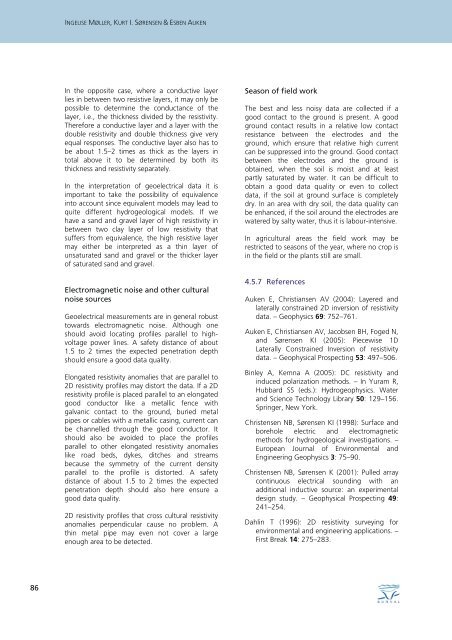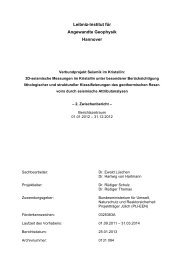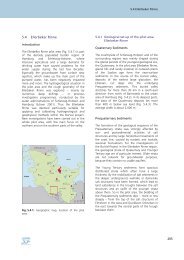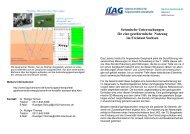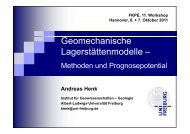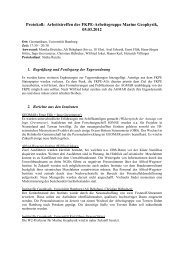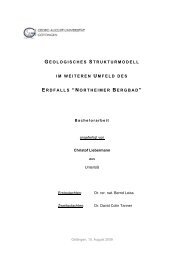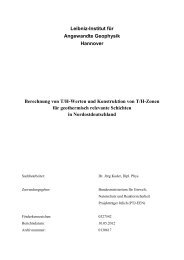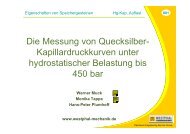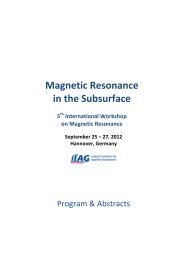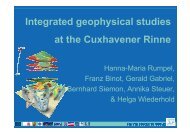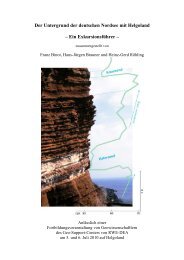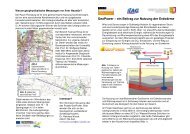4.5 Geoelectrical methods - LIAG
4.5 Geoelectrical methods - LIAG
4.5 Geoelectrical methods - LIAG
You also want an ePaper? Increase the reach of your titles
YUMPU automatically turns print PDFs into web optimized ePapers that Google loves.
86<br />
INGELISE MØLLER, KURT I. SØRENSEN & ESBEN AUKEN<br />
In the opposite case, where a conductive layer<br />
lies in between two resistive layers, it may only be<br />
possible to determine the conductance of the<br />
layer, i.e., the thickness divided by the resistivity.<br />
Therefore a conductive layer and a layer with the<br />
double resistivity and double thickness give very<br />
equal responses. The conductive layer also has to<br />
be about 1.5–2 times as thick as the layers in<br />
total above it to be determined by both its<br />
thickness and resistivity separately.<br />
In the interpretation of geoelectrical data it is<br />
important to take the possibility of equivalence<br />
into account since equivalent models may lead to<br />
quite different hydrogeological models. If we<br />
have a sand and gravel layer of high resistivity in<br />
between two clay layer of low resistivity that<br />
suffers from equivalence, the high resistive layer<br />
may either be interpreted as a thin layer of<br />
unsaturated sand and gravel or the thicker layer<br />
of saturated sand and gravel.<br />
Electromagnetic noise and other cultural<br />
noise sources<br />
<strong>Geoelectrical</strong> measurements are in general robust<br />
towards electromagnetic noise. Although one<br />
should avoid locating profiles parallel to highvoltage<br />
power lines. A safety distance of about<br />
1.5 to 2 times the expected penetration depth<br />
should ensure a good data quality.<br />
Elongated resistivity anomalies that are parallel to<br />
2D resistivity profiles may distort the data. If a 2D<br />
resistivity profile is placed parallel to an elongated<br />
good conductor like a metallic fence with<br />
galvanic contact to the ground, buried metal<br />
pipes or cables with a metallic casing, current can<br />
be channelled through the good conductor. It<br />
should also be avoided to place the profiles<br />
parallel to other elongated resistivity anomalies<br />
like road beds, dykes, ditches and streams<br />
because the symmetry of the current density<br />
parallel to the profile is distorted. A safety<br />
distance of about 1.5 to 2 times the expected<br />
penetration depth should also here ensure a<br />
good data quality.<br />
2D resistivity profiles that cross cultural resistivity<br />
anomalies perpendicular cause no problem. A<br />
thin metal pipe may even not cover a large<br />
enough area to be detected.<br />
Season of field work<br />
The best and less noisy data are collected if a<br />
good contact to the ground is present. A good<br />
ground contact results in a relative low contact<br />
resistance between the electrodes and the<br />
ground, which ensure that relative high current<br />
can be suppressed into the ground. Good contact<br />
between the electrodes and the ground is<br />
obtained, when the soil is moist and at least<br />
partly saturated by water. It can be difficult to<br />
obtain a good data quality or even to collect<br />
data, if the soil at ground surface is completely<br />
dry. In an area with dry soil, the data quality can<br />
be enhanced, if the soil around the electrodes are<br />
watered by salty water, thus it is labour-intensive.<br />
In agricultural areas the field work may be<br />
restricted to seasons of the year, where no crop is<br />
in the field or the plants still are small.<br />
<strong>4.5</strong>.7 References<br />
Auken E, Christiansen AV (2004): Layered and<br />
laterally constrained 2D inversion of resistivity<br />
data. – Geophysics 69: 752–761.<br />
Auken E, Christiansen AV, Jacobsen BH, Foged N,<br />
and Sørensen KI (2005): Piecewise 1D<br />
Laterally Constrained Inversion of resistivity<br />
data. – Geophysical Prospecting 53: 497–506.<br />
Binley A, Kemna A (2005): DC resistivity and<br />
induced polarization <strong>methods</strong>. – In Yuram R,<br />
Hubbard SS (eds.): Hydrogeophysics. Water<br />
and Science Technology Library 50: 129–156.<br />
Springer, New York.<br />
Christensen NB, Sørensen KI (1998): Surface and<br />
borehole electric and electromagnetic<br />
<strong>methods</strong> for hydrogeological investigations. –<br />
European Journal of Environmental and<br />
Engineering Geophysics 3: 75–90.<br />
Christensen NB, Sørensen K (2001): Pulled array<br />
continuous electrical sounding with an<br />
additional inductive source: an experimental<br />
design study. – Geophysical Prospecting 49:<br />
241–254.<br />
Dahlin T (1996): 2D resistivity surveying for<br />
environmental and engineering applications. –<br />
First Break 14: 275–283.


